Analyzing Quality Management in Health and Social Care Context
VerifiedAdded on 2024/06/27
|18
|5485
|269
Report
AI Summary
This report provides a comprehensive analysis of quality management in the health and social care sector, focusing on the Royal United Hospital Bath NHS Trust. It explores different stakeholder perspectives on quality, assesses the impact of poor service quality, and analyzes the role of external agencies in setting standards. The report also examines strategies for achieving quality, potential barriers to service delivery, and various approaches to implementing quality systems. Furthermore, it evaluates methodologies for assessing service quality from both internal and external perspectives, discusses the impact of user involvement in the evaluation process, and analyzes factors influencing the achievement of quality. The report concludes by suggesting ways to improve quality within the health and social care context.
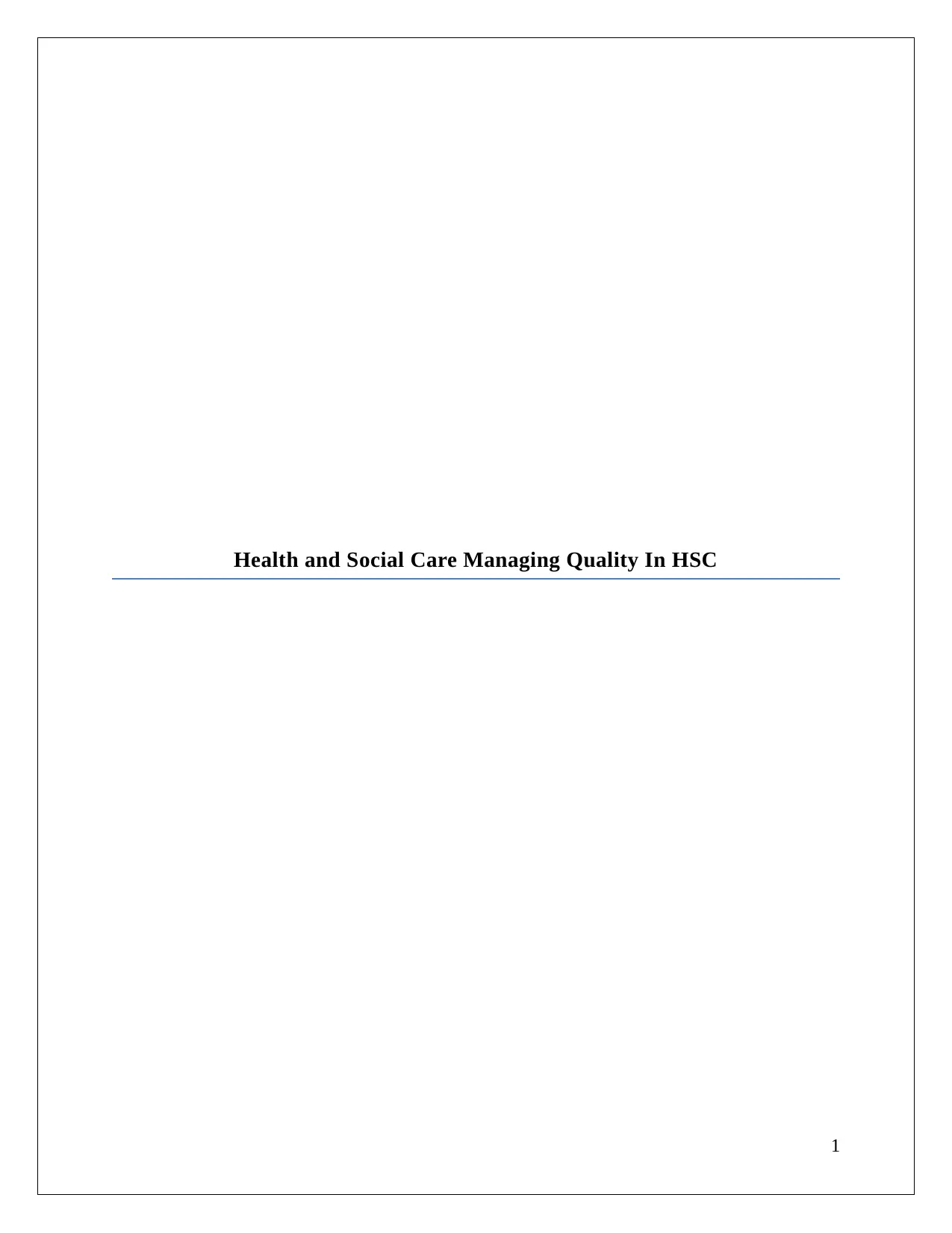
Health and Social Care Managing Quality In HSC
1
1
Paraphrase This Document
Need a fresh take? Get an instant paraphrase of this document with our AI Paraphraser
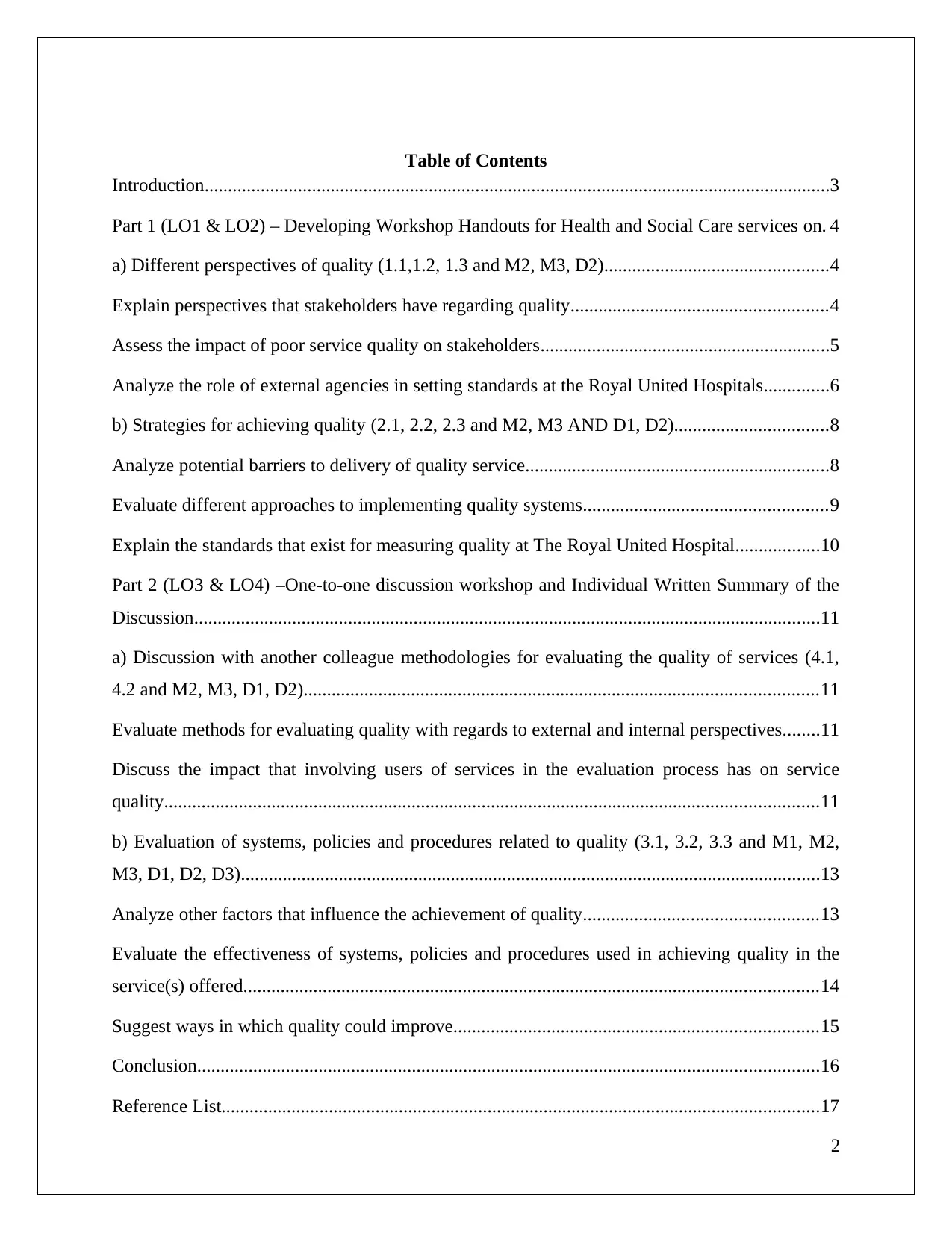
Table of Contents
Introduction......................................................................................................................................3
Part 1 (LO1 & LO2) – Developing Workshop Handouts for Health and Social Care services on. 4
a) Different perspectives of quality (1.1,1.2, 1.3 and M2, M3, D2)................................................4
Explain perspectives that stakeholders have regarding quality.......................................................4
Assess the impact of poor service quality on stakeholders..............................................................5
Analyze the role of external agencies in setting standards at the Royal United Hospitals..............6
b) Strategies for achieving quality (2.1, 2.2, 2.3 and M2, M3 AND D1, D2).................................8
Analyze potential barriers to delivery of quality service.................................................................8
Evaluate different approaches to implementing quality systems....................................................9
Explain the standards that exist for measuring quality at The Royal United Hospital..................10
Part 2 (LO3 & LO4) –One-to-one discussion workshop and Individual Written Summary of the
Discussion......................................................................................................................................11
a) Discussion with another colleague methodologies for evaluating the quality of services (4.1,
4.2 and M2, M3, D1, D2)..............................................................................................................11
Evaluate methods for evaluating quality with regards to external and internal perspectives........11
Discuss the impact that involving users of services in the evaluation process has on service
quality............................................................................................................................................11
b) Evaluation of systems, policies and procedures related to quality (3.1, 3.2, 3.3 and M1, M2,
M3, D1, D2, D3)............................................................................................................................13
Analyze other factors that influence the achievement of quality..................................................13
Evaluate the effectiveness of systems, policies and procedures used in achieving quality in the
service(s) offered...........................................................................................................................14
Suggest ways in which quality could improve..............................................................................15
Conclusion.....................................................................................................................................16
Reference List................................................................................................................................17
2
Introduction......................................................................................................................................3
Part 1 (LO1 & LO2) – Developing Workshop Handouts for Health and Social Care services on. 4
a) Different perspectives of quality (1.1,1.2, 1.3 and M2, M3, D2)................................................4
Explain perspectives that stakeholders have regarding quality.......................................................4
Assess the impact of poor service quality on stakeholders..............................................................5
Analyze the role of external agencies in setting standards at the Royal United Hospitals..............6
b) Strategies for achieving quality (2.1, 2.2, 2.3 and M2, M3 AND D1, D2).................................8
Analyze potential barriers to delivery of quality service.................................................................8
Evaluate different approaches to implementing quality systems....................................................9
Explain the standards that exist for measuring quality at The Royal United Hospital..................10
Part 2 (LO3 & LO4) –One-to-one discussion workshop and Individual Written Summary of the
Discussion......................................................................................................................................11
a) Discussion with another colleague methodologies for evaluating the quality of services (4.1,
4.2 and M2, M3, D1, D2)..............................................................................................................11
Evaluate methods for evaluating quality with regards to external and internal perspectives........11
Discuss the impact that involving users of services in the evaluation process has on service
quality............................................................................................................................................11
b) Evaluation of systems, policies and procedures related to quality (3.1, 3.2, 3.3 and M1, M2,
M3, D1, D2, D3)............................................................................................................................13
Analyze other factors that influence the achievement of quality..................................................13
Evaluate the effectiveness of systems, policies and procedures used in achieving quality in the
service(s) offered...........................................................................................................................14
Suggest ways in which quality could improve..............................................................................15
Conclusion.....................................................................................................................................16
Reference List................................................................................................................................17
2
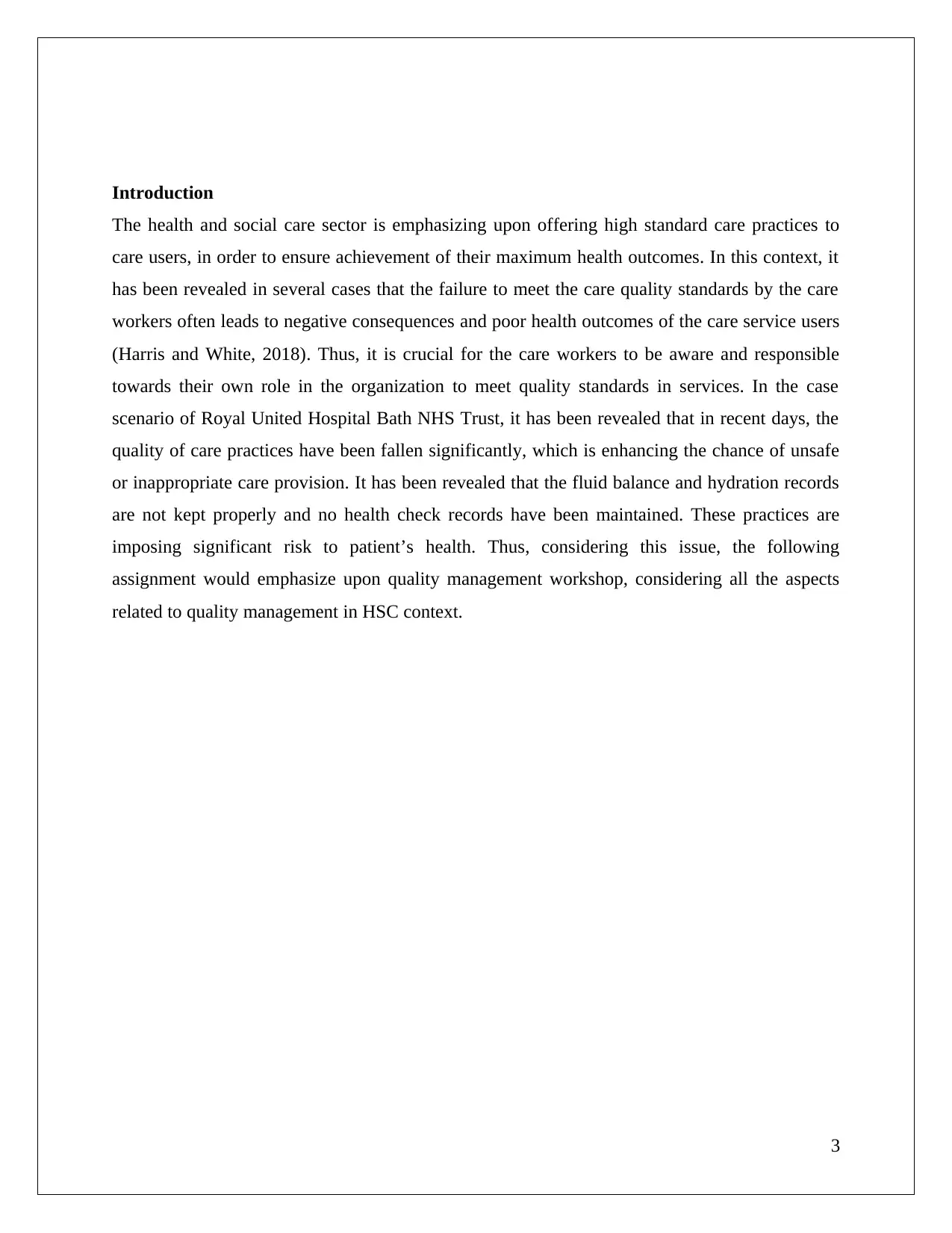
Introduction
The health and social care sector is emphasizing upon offering high standard care practices to
care users, in order to ensure achievement of their maximum health outcomes. In this context, it
has been revealed in several cases that the failure to meet the care quality standards by the care
workers often leads to negative consequences and poor health outcomes of the care service users
(Harris and White, 2018). Thus, it is crucial for the care workers to be aware and responsible
towards their own role in the organization to meet quality standards in services. In the case
scenario of Royal United Hospital Bath NHS Trust, it has been revealed that in recent days, the
quality of care practices have been fallen significantly, which is enhancing the chance of unsafe
or inappropriate care provision. It has been revealed that the fluid balance and hydration records
are not kept properly and no health check records have been maintained. These practices are
imposing significant risk to patient’s health. Thus, considering this issue, the following
assignment would emphasize upon quality management workshop, considering all the aspects
related to quality management in HSC context.
3
The health and social care sector is emphasizing upon offering high standard care practices to
care users, in order to ensure achievement of their maximum health outcomes. In this context, it
has been revealed in several cases that the failure to meet the care quality standards by the care
workers often leads to negative consequences and poor health outcomes of the care service users
(Harris and White, 2018). Thus, it is crucial for the care workers to be aware and responsible
towards their own role in the organization to meet quality standards in services. In the case
scenario of Royal United Hospital Bath NHS Trust, it has been revealed that in recent days, the
quality of care practices have been fallen significantly, which is enhancing the chance of unsafe
or inappropriate care provision. It has been revealed that the fluid balance and hydration records
are not kept properly and no health check records have been maintained. These practices are
imposing significant risk to patient’s health. Thus, considering this issue, the following
assignment would emphasize upon quality management workshop, considering all the aspects
related to quality management in HSC context.
3
⊘ This is a preview!⊘
Do you want full access?
Subscribe today to unlock all pages.

Trusted by 1+ million students worldwide
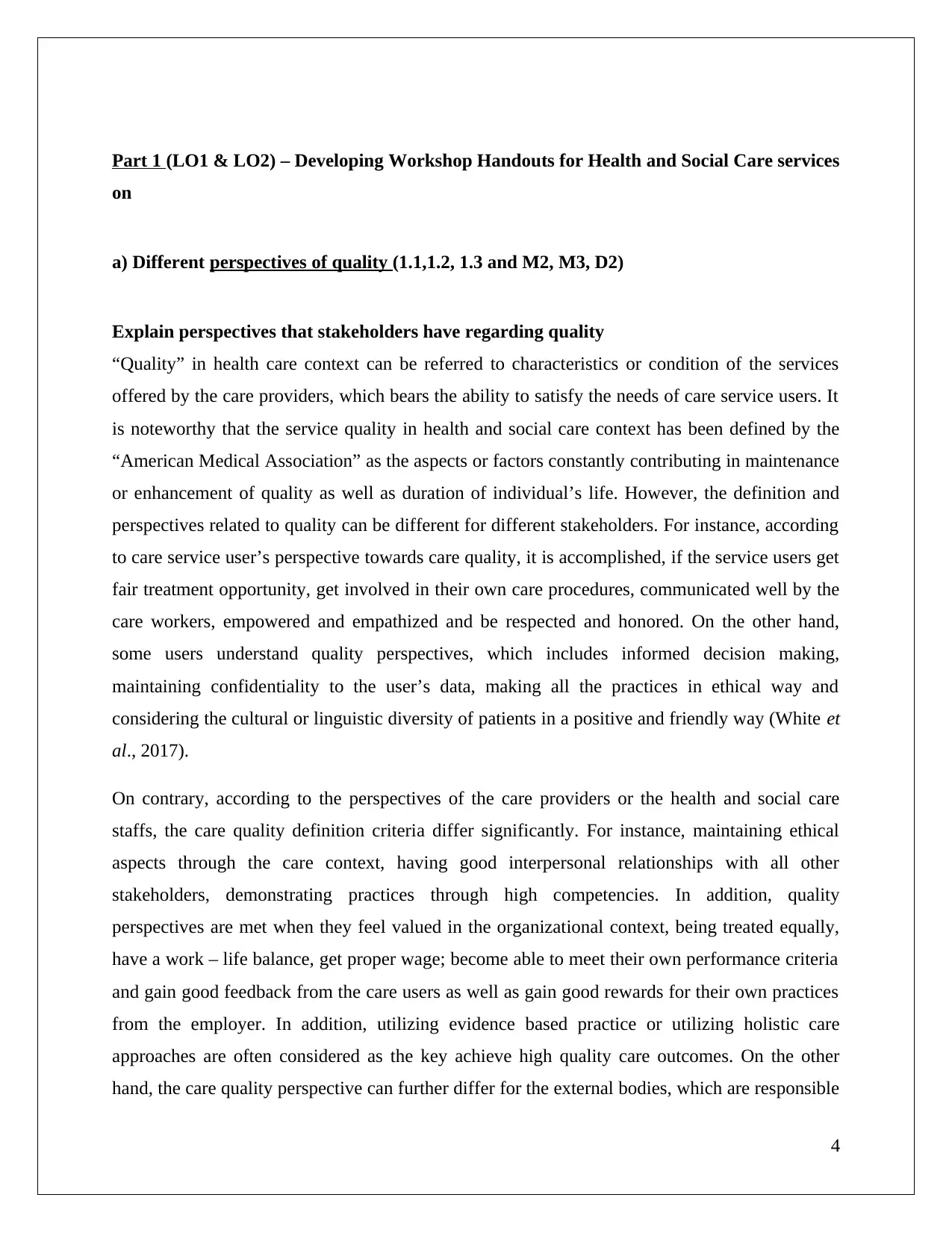
Part 1 (LO1 & LO2) – Developing Workshop Handouts for Health and Social Care services
on
a) Different perspectives of quality (1.1,1.2, 1.3 and M2, M3, D2)
Explain perspectives that stakeholders have regarding quality
“Quality” in health care context can be referred to characteristics or condition of the services
offered by the care providers, which bears the ability to satisfy the needs of care service users. It
is noteworthy that the service quality in health and social care context has been defined by the
“American Medical Association” as the aspects or factors constantly contributing in maintenance
or enhancement of quality as well as duration of individual’s life. However, the definition and
perspectives related to quality can be different for different stakeholders. For instance, according
to care service user’s perspective towards care quality, it is accomplished, if the service users get
fair treatment opportunity, get involved in their own care procedures, communicated well by the
care workers, empowered and empathized and be respected and honored. On the other hand,
some users understand quality perspectives, which includes informed decision making,
maintaining confidentiality to the user’s data, making all the practices in ethical way and
considering the cultural or linguistic diversity of patients in a positive and friendly way (White et
al., 2017).
On contrary, according to the perspectives of the care providers or the health and social care
staffs, the care quality definition criteria differ significantly. For instance, maintaining ethical
aspects through the care context, having good interpersonal relationships with all other
stakeholders, demonstrating practices through high competencies. In addition, quality
perspectives are met when they feel valued in the organizational context, being treated equally,
have a work – life balance, get proper wage; become able to meet their own performance criteria
and gain good feedback from the care users as well as gain good rewards for their own practices
from the employer. In addition, utilizing evidence based practice or utilizing holistic care
approaches are often considered as the key achieve high quality care outcomes. On the other
hand, the care quality perspective can further differ for the external bodies, which are responsible
4
on
a) Different perspectives of quality (1.1,1.2, 1.3 and M2, M3, D2)
Explain perspectives that stakeholders have regarding quality
“Quality” in health care context can be referred to characteristics or condition of the services
offered by the care providers, which bears the ability to satisfy the needs of care service users. It
is noteworthy that the service quality in health and social care context has been defined by the
“American Medical Association” as the aspects or factors constantly contributing in maintenance
or enhancement of quality as well as duration of individual’s life. However, the definition and
perspectives related to quality can be different for different stakeholders. For instance, according
to care service user’s perspective towards care quality, it is accomplished, if the service users get
fair treatment opportunity, get involved in their own care procedures, communicated well by the
care workers, empowered and empathized and be respected and honored. On the other hand,
some users understand quality perspectives, which includes informed decision making,
maintaining confidentiality to the user’s data, making all the practices in ethical way and
considering the cultural or linguistic diversity of patients in a positive and friendly way (White et
al., 2017).
On contrary, according to the perspectives of the care providers or the health and social care
staffs, the care quality definition criteria differ significantly. For instance, maintaining ethical
aspects through the care context, having good interpersonal relationships with all other
stakeholders, demonstrating practices through high competencies. In addition, quality
perspectives are met when they feel valued in the organizational context, being treated equally,
have a work – life balance, get proper wage; become able to meet their own performance criteria
and gain good feedback from the care users as well as gain good rewards for their own practices
from the employer. In addition, utilizing evidence based practice or utilizing holistic care
approaches are often considered as the key achieve high quality care outcomes. On the other
hand, the care quality perspective can further differ for the external bodies, which are responsible
4
Paraphrase This Document
Need a fresh take? Get an instant paraphrase of this document with our AI Paraphraser
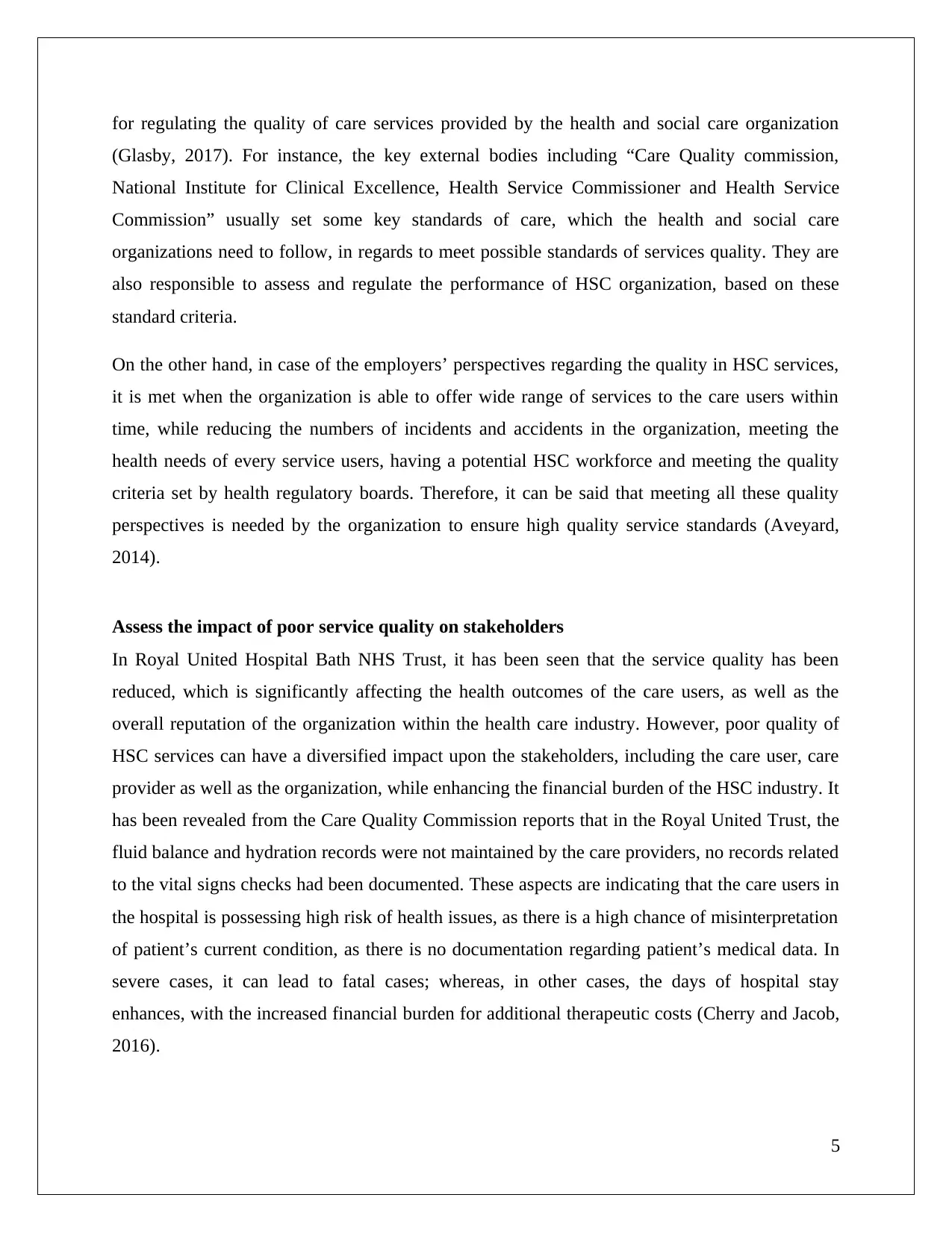
for regulating the quality of care services provided by the health and social care organization
(Glasby, 2017). For instance, the key external bodies including “Care Quality commission,
National Institute for Clinical Excellence, Health Service Commissioner and Health Service
Commission” usually set some key standards of care, which the health and social care
organizations need to follow, in regards to meet possible standards of services quality. They are
also responsible to assess and regulate the performance of HSC organization, based on these
standard criteria.
On the other hand, in case of the employers’ perspectives regarding the quality in HSC services,
it is met when the organization is able to offer wide range of services to the care users within
time, while reducing the numbers of incidents and accidents in the organization, meeting the
health needs of every service users, having a potential HSC workforce and meeting the quality
criteria set by health regulatory boards. Therefore, it can be said that meeting all these quality
perspectives is needed by the organization to ensure high quality service standards (Aveyard,
2014).
Assess the impact of poor service quality on stakeholders
In Royal United Hospital Bath NHS Trust, it has been seen that the service quality has been
reduced, which is significantly affecting the health outcomes of the care users, as well as the
overall reputation of the organization within the health care industry. However, poor quality of
HSC services can have a diversified impact upon the stakeholders, including the care user, care
provider as well as the organization, while enhancing the financial burden of the HSC industry. It
has been revealed from the Care Quality Commission reports that in the Royal United Trust, the
fluid balance and hydration records were not maintained by the care providers, no records related
to the vital signs checks had been documented. These aspects are indicating that the care users in
the hospital is possessing high risk of health issues, as there is a high chance of misinterpretation
of patient’s current condition, as there is no documentation regarding patient’s medical data. In
severe cases, it can lead to fatal cases; whereas, in other cases, the days of hospital stay
enhances, with the increased financial burden for additional therapeutic costs (Cherry and Jacob,
2016).
5
(Glasby, 2017). For instance, the key external bodies including “Care Quality commission,
National Institute for Clinical Excellence, Health Service Commissioner and Health Service
Commission” usually set some key standards of care, which the health and social care
organizations need to follow, in regards to meet possible standards of services quality. They are
also responsible to assess and regulate the performance of HSC organization, based on these
standard criteria.
On the other hand, in case of the employers’ perspectives regarding the quality in HSC services,
it is met when the organization is able to offer wide range of services to the care users within
time, while reducing the numbers of incidents and accidents in the organization, meeting the
health needs of every service users, having a potential HSC workforce and meeting the quality
criteria set by health regulatory boards. Therefore, it can be said that meeting all these quality
perspectives is needed by the organization to ensure high quality service standards (Aveyard,
2014).
Assess the impact of poor service quality on stakeholders
In Royal United Hospital Bath NHS Trust, it has been seen that the service quality has been
reduced, which is significantly affecting the health outcomes of the care users, as well as the
overall reputation of the organization within the health care industry. However, poor quality of
HSC services can have a diversified impact upon the stakeholders, including the care user, care
provider as well as the organization, while enhancing the financial burden of the HSC industry. It
has been revealed from the Care Quality Commission reports that in the Royal United Trust, the
fluid balance and hydration records were not maintained by the care providers, no records related
to the vital signs checks had been documented. These aspects are indicating that the care users in
the hospital is possessing high risk of health issues, as there is a high chance of misinterpretation
of patient’s current condition, as there is no documentation regarding patient’s medical data. In
severe cases, it can lead to fatal cases; whereas, in other cases, the days of hospital stay
enhances, with the increased financial burden for additional therapeutic costs (Cherry and Jacob,
2016).
5
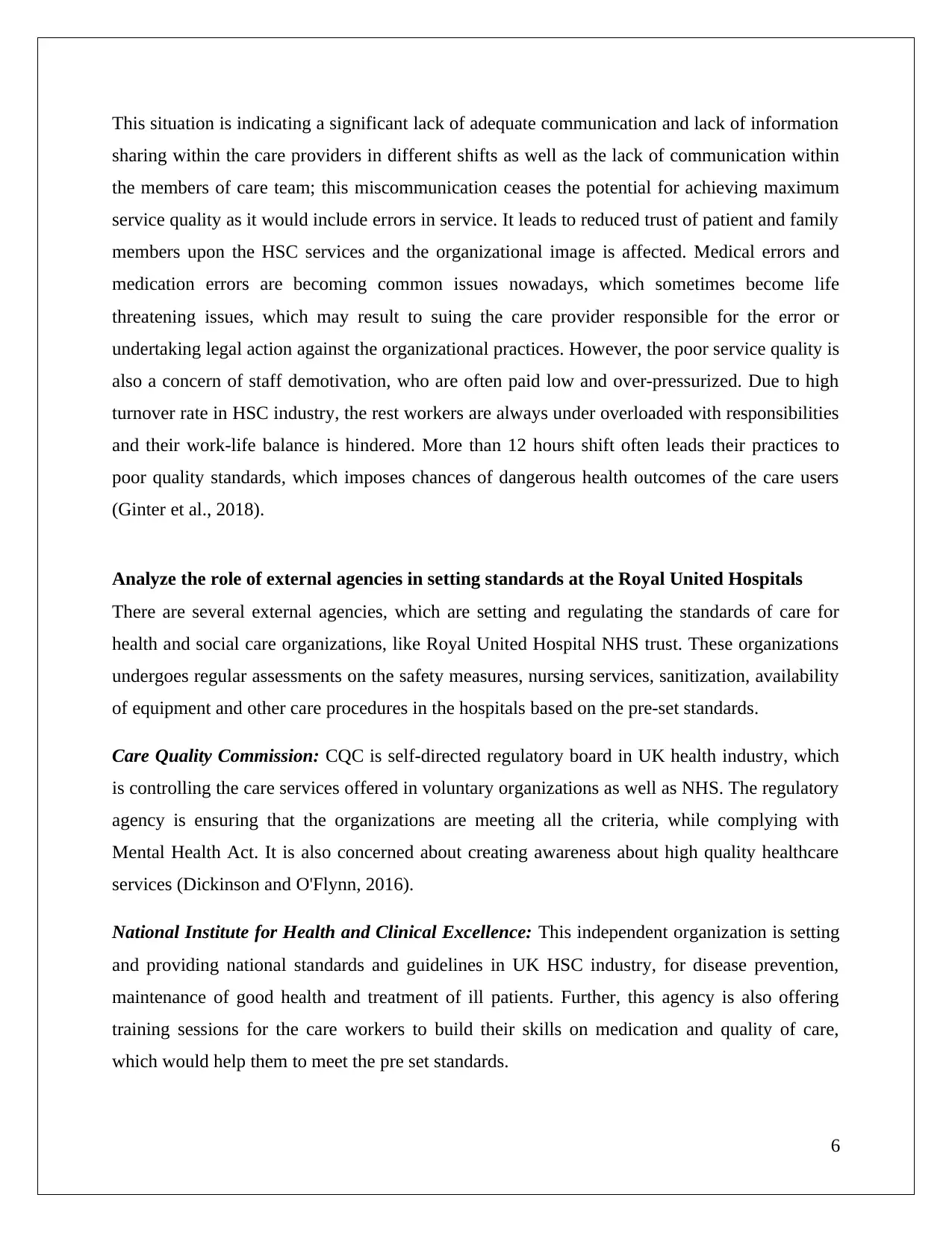
This situation is indicating a significant lack of adequate communication and lack of information
sharing within the care providers in different shifts as well as the lack of communication within
the members of care team; this miscommunication ceases the potential for achieving maximum
service quality as it would include errors in service. It leads to reduced trust of patient and family
members upon the HSC services and the organizational image is affected. Medical errors and
medication errors are becoming common issues nowadays, which sometimes become life
threatening issues, which may result to suing the care provider responsible for the error or
undertaking legal action against the organizational practices. However, the poor service quality is
also a concern of staff demotivation, who are often paid low and over-pressurized. Due to high
turnover rate in HSC industry, the rest workers are always under overloaded with responsibilities
and their work-life balance is hindered. More than 12 hours shift often leads their practices to
poor quality standards, which imposes chances of dangerous health outcomes of the care users
(Ginter et al., 2018).
Analyze the role of external agencies in setting standards at the Royal United Hospitals
There are several external agencies, which are setting and regulating the standards of care for
health and social care organizations, like Royal United Hospital NHS trust. These organizations
undergoes regular assessments on the safety measures, nursing services, sanitization, availability
of equipment and other care procedures in the hospitals based on the pre-set standards.
Care Quality Commission: CQC is self-directed regulatory board in UK health industry, which
is controlling the care services offered in voluntary organizations as well as NHS. The regulatory
agency is ensuring that the organizations are meeting all the criteria, while complying with
Mental Health Act. It is also concerned about creating awareness about high quality healthcare
services (Dickinson and O'Flynn, 2016).
National Institute for Health and Clinical Excellence: This independent organization is setting
and providing national standards and guidelines in UK HSC industry, for disease prevention,
maintenance of good health and treatment of ill patients. Further, this agency is also offering
training sessions for the care workers to build their skills on medication and quality of care,
which would help them to meet the pre set standards.
6
sharing within the care providers in different shifts as well as the lack of communication within
the members of care team; this miscommunication ceases the potential for achieving maximum
service quality as it would include errors in service. It leads to reduced trust of patient and family
members upon the HSC services and the organizational image is affected. Medical errors and
medication errors are becoming common issues nowadays, which sometimes become life
threatening issues, which may result to suing the care provider responsible for the error or
undertaking legal action against the organizational practices. However, the poor service quality is
also a concern of staff demotivation, who are often paid low and over-pressurized. Due to high
turnover rate in HSC industry, the rest workers are always under overloaded with responsibilities
and their work-life balance is hindered. More than 12 hours shift often leads their practices to
poor quality standards, which imposes chances of dangerous health outcomes of the care users
(Ginter et al., 2018).
Analyze the role of external agencies in setting standards at the Royal United Hospitals
There are several external agencies, which are setting and regulating the standards of care for
health and social care organizations, like Royal United Hospital NHS trust. These organizations
undergoes regular assessments on the safety measures, nursing services, sanitization, availability
of equipment and other care procedures in the hospitals based on the pre-set standards.
Care Quality Commission: CQC is self-directed regulatory board in UK health industry, which
is controlling the care services offered in voluntary organizations as well as NHS. The regulatory
agency is ensuring that the organizations are meeting all the criteria, while complying with
Mental Health Act. It is also concerned about creating awareness about high quality healthcare
services (Dickinson and O'Flynn, 2016).
National Institute for Health and Clinical Excellence: This independent organization is setting
and providing national standards and guidelines in UK HSC industry, for disease prevention,
maintenance of good health and treatment of ill patients. Further, this agency is also offering
training sessions for the care workers to build their skills on medication and quality of care,
which would help them to meet the pre set standards.
6
⊘ This is a preview!⊘
Do you want full access?
Subscribe today to unlock all pages.

Trusted by 1+ million students worldwide
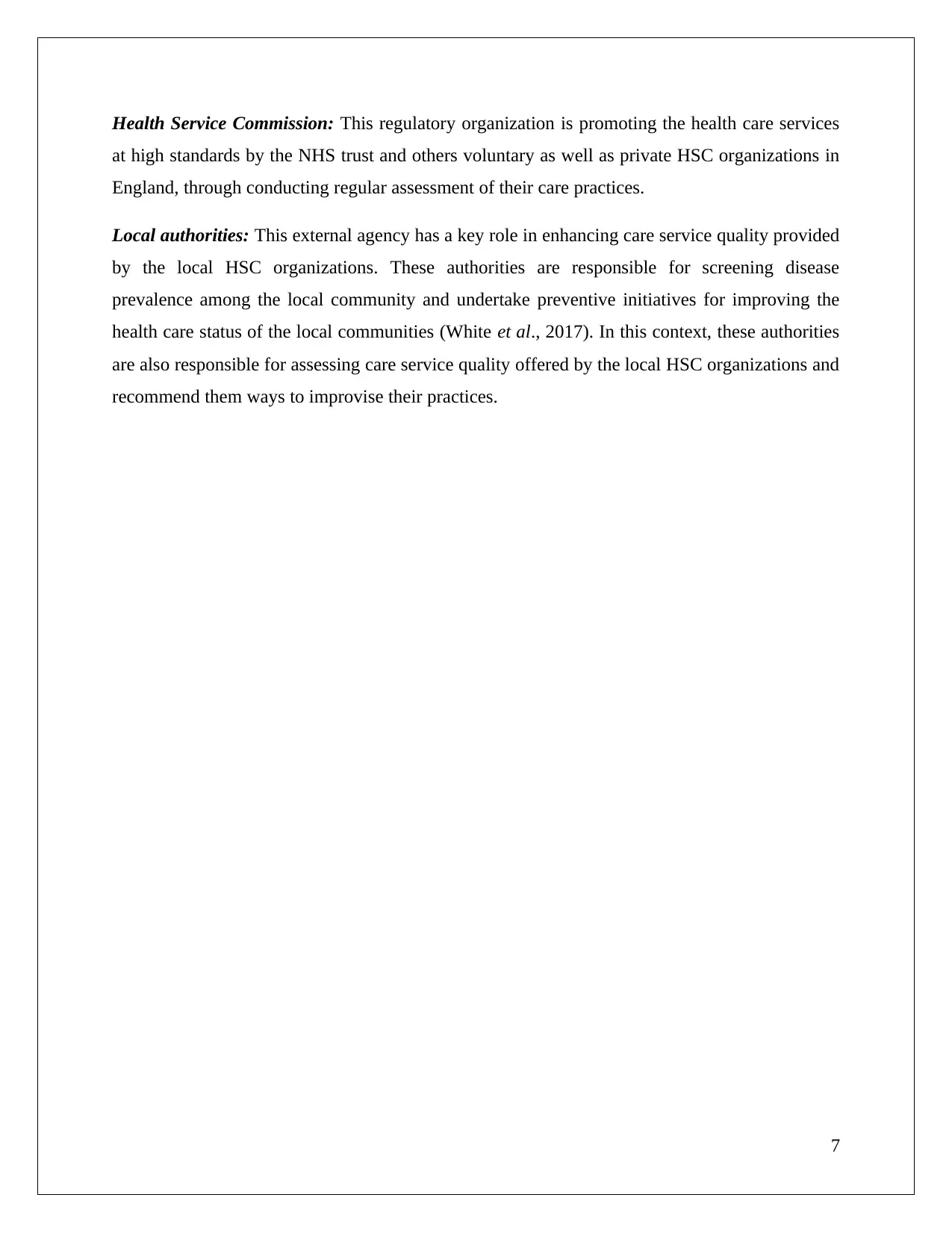
Health Service Commission: This regulatory organization is promoting the health care services
at high standards by the NHS trust and others voluntary as well as private HSC organizations in
England, through conducting regular assessment of their care practices.
Local authorities: This external agency has a key role in enhancing care service quality provided
by the local HSC organizations. These authorities are responsible for screening disease
prevalence among the local community and undertake preventive initiatives for improving the
health care status of the local communities (White et al., 2017). In this context, these authorities
are also responsible for assessing care service quality offered by the local HSC organizations and
recommend them ways to improvise their practices.
7
at high standards by the NHS trust and others voluntary as well as private HSC organizations in
England, through conducting regular assessment of their care practices.
Local authorities: This external agency has a key role in enhancing care service quality provided
by the local HSC organizations. These authorities are responsible for screening disease
prevalence among the local community and undertake preventive initiatives for improving the
health care status of the local communities (White et al., 2017). In this context, these authorities
are also responsible for assessing care service quality offered by the local HSC organizations and
recommend them ways to improvise their practices.
7
Paraphrase This Document
Need a fresh take? Get an instant paraphrase of this document with our AI Paraphraser
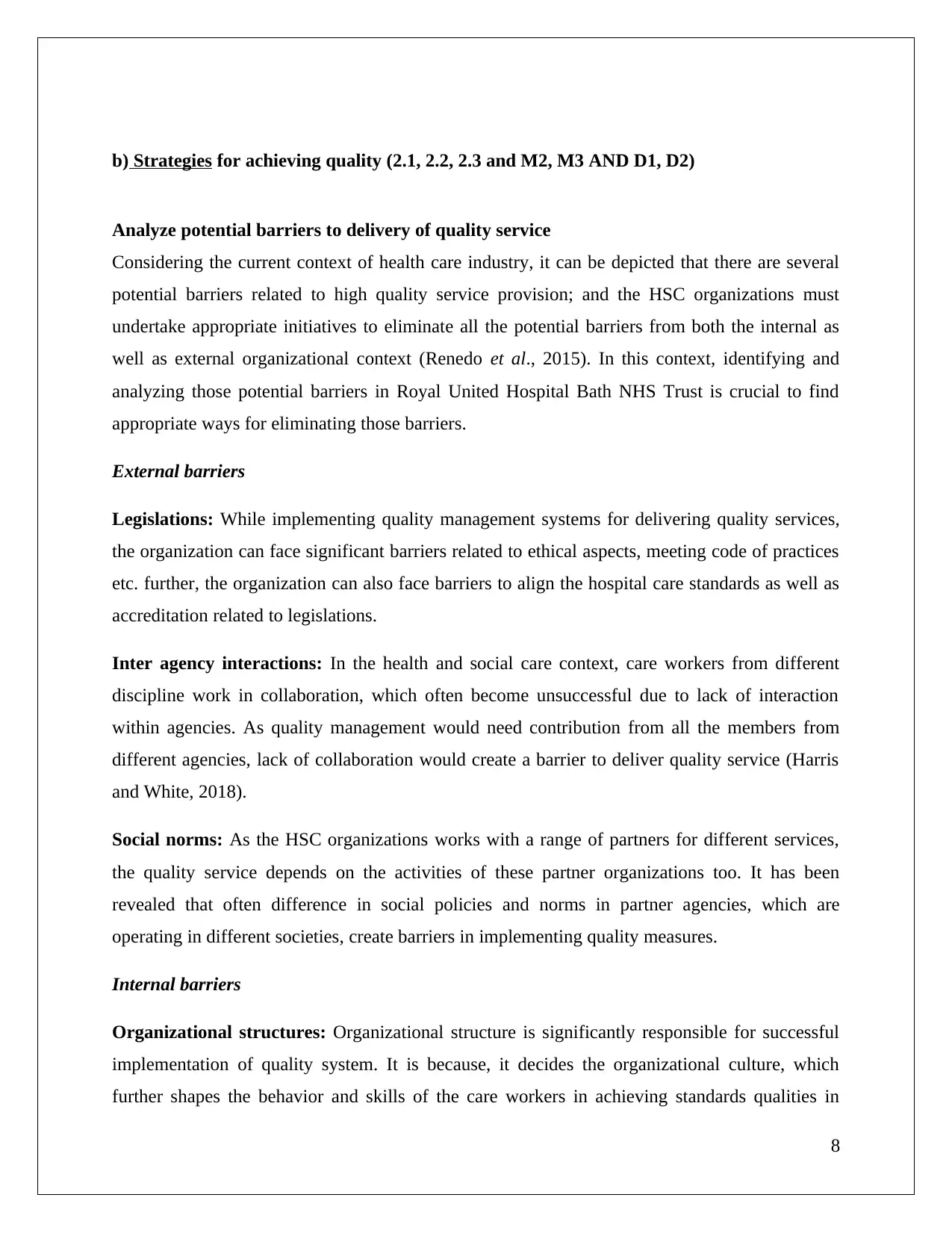
b) Strategies for achieving quality (2.1, 2.2, 2.3 and M2, M3 AND D1, D2)
Analyze potential barriers to delivery of quality service
Considering the current context of health care industry, it can be depicted that there are several
potential barriers related to high quality service provision; and the HSC organizations must
undertake appropriate initiatives to eliminate all the potential barriers from both the internal as
well as external organizational context (Renedo et al., 2015). In this context, identifying and
analyzing those potential barriers in Royal United Hospital Bath NHS Trust is crucial to find
appropriate ways for eliminating those barriers.
External barriers
Legislations: While implementing quality management systems for delivering quality services,
the organization can face significant barriers related to ethical aspects, meeting code of practices
etc. further, the organization can also face barriers to align the hospital care standards as well as
accreditation related to legislations.
Inter agency interactions: In the health and social care context, care workers from different
discipline work in collaboration, which often become unsuccessful due to lack of interaction
within agencies. As quality management would need contribution from all the members from
different agencies, lack of collaboration would create a barrier to deliver quality service (Harris
and White, 2018).
Social norms: As the HSC organizations works with a range of partners for different services,
the quality service depends on the activities of these partner organizations too. It has been
revealed that often difference in social policies and norms in partner agencies, which are
operating in different societies, create barriers in implementing quality measures.
Internal barriers
Organizational structures: Organizational structure is significantly responsible for successful
implementation of quality system. It is because, it decides the organizational culture, which
further shapes the behavior and skills of the care workers in achieving standards qualities in
8
Analyze potential barriers to delivery of quality service
Considering the current context of health care industry, it can be depicted that there are several
potential barriers related to high quality service provision; and the HSC organizations must
undertake appropriate initiatives to eliminate all the potential barriers from both the internal as
well as external organizational context (Renedo et al., 2015). In this context, identifying and
analyzing those potential barriers in Royal United Hospital Bath NHS Trust is crucial to find
appropriate ways for eliminating those barriers.
External barriers
Legislations: While implementing quality management systems for delivering quality services,
the organization can face significant barriers related to ethical aspects, meeting code of practices
etc. further, the organization can also face barriers to align the hospital care standards as well as
accreditation related to legislations.
Inter agency interactions: In the health and social care context, care workers from different
discipline work in collaboration, which often become unsuccessful due to lack of interaction
within agencies. As quality management would need contribution from all the members from
different agencies, lack of collaboration would create a barrier to deliver quality service (Harris
and White, 2018).
Social norms: As the HSC organizations works with a range of partners for different services,
the quality service depends on the activities of these partner organizations too. It has been
revealed that often difference in social policies and norms in partner agencies, which are
operating in different societies, create barriers in implementing quality measures.
Internal barriers
Organizational structures: Organizational structure is significantly responsible for successful
implementation of quality system. It is because, it decides the organizational culture, which
further shapes the behavior and skills of the care workers in achieving standards qualities in
8
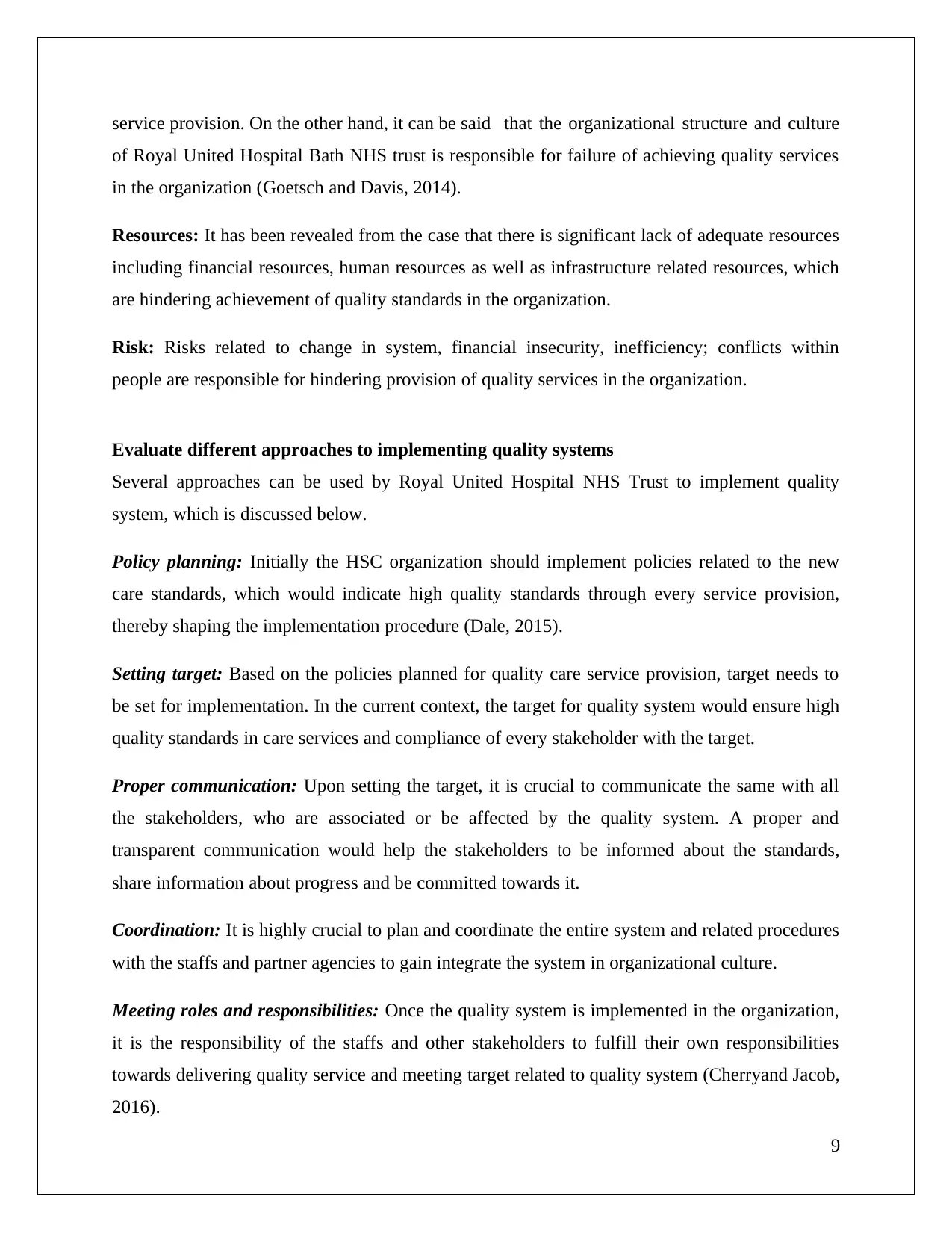
service provision. On the other hand, it can be said that the organizational structure and culture
of Royal United Hospital Bath NHS trust is responsible for failure of achieving quality services
in the organization (Goetsch and Davis, 2014).
Resources: It has been revealed from the case that there is significant lack of adequate resources
including financial resources, human resources as well as infrastructure related resources, which
are hindering achievement of quality standards in the organization.
Risk: Risks related to change in system, financial insecurity, inefficiency; conflicts within
people are responsible for hindering provision of quality services in the organization.
Evaluate different approaches to implementing quality systems
Several approaches can be used by Royal United Hospital NHS Trust to implement quality
system, which is discussed below.
Policy planning: Initially the HSC organization should implement policies related to the new
care standards, which would indicate high quality standards through every service provision,
thereby shaping the implementation procedure (Dale, 2015).
Setting target: Based on the policies planned for quality care service provision, target needs to
be set for implementation. In the current context, the target for quality system would ensure high
quality standards in care services and compliance of every stakeholder with the target.
Proper communication: Upon setting the target, it is crucial to communicate the same with all
the stakeholders, who are associated or be affected by the quality system. A proper and
transparent communication would help the stakeholders to be informed about the standards,
share information about progress and be committed towards it.
Coordination: It is highly crucial to plan and coordinate the entire system and related procedures
with the staffs and partner agencies to gain integrate the system in organizational culture.
Meeting roles and responsibilities: Once the quality system is implemented in the organization,
it is the responsibility of the staffs and other stakeholders to fulfill their own responsibilities
towards delivering quality service and meeting target related to quality system (Cherryand Jacob,
2016).
9
of Royal United Hospital Bath NHS trust is responsible for failure of achieving quality services
in the organization (Goetsch and Davis, 2014).
Resources: It has been revealed from the case that there is significant lack of adequate resources
including financial resources, human resources as well as infrastructure related resources, which
are hindering achievement of quality standards in the organization.
Risk: Risks related to change in system, financial insecurity, inefficiency; conflicts within
people are responsible for hindering provision of quality services in the organization.
Evaluate different approaches to implementing quality systems
Several approaches can be used by Royal United Hospital NHS Trust to implement quality
system, which is discussed below.
Policy planning: Initially the HSC organization should implement policies related to the new
care standards, which would indicate high quality standards through every service provision,
thereby shaping the implementation procedure (Dale, 2015).
Setting target: Based on the policies planned for quality care service provision, target needs to
be set for implementation. In the current context, the target for quality system would ensure high
quality standards in care services and compliance of every stakeholder with the target.
Proper communication: Upon setting the target, it is crucial to communicate the same with all
the stakeholders, who are associated or be affected by the quality system. A proper and
transparent communication would help the stakeholders to be informed about the standards,
share information about progress and be committed towards it.
Coordination: It is highly crucial to plan and coordinate the entire system and related procedures
with the staffs and partner agencies to gain integrate the system in organizational culture.
Meeting roles and responsibilities: Once the quality system is implemented in the organization,
it is the responsibility of the staffs and other stakeholders to fulfill their own responsibilities
towards delivering quality service and meeting target related to quality system (Cherryand Jacob,
2016).
9
⊘ This is a preview!⊘
Do you want full access?
Subscribe today to unlock all pages.

Trusted by 1+ million students worldwide
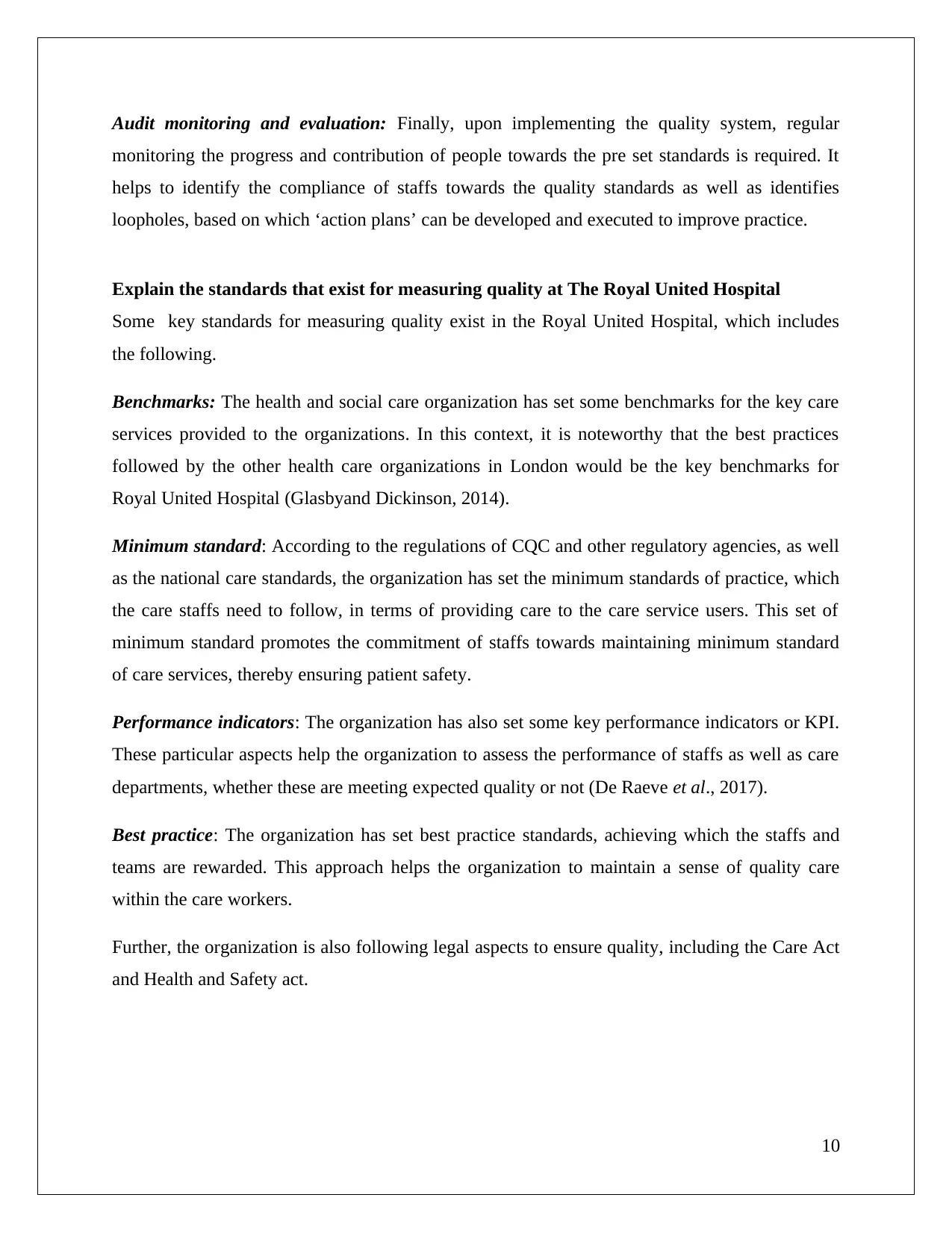
Audit monitoring and evaluation: Finally, upon implementing the quality system, regular
monitoring the progress and contribution of people towards the pre set standards is required. It
helps to identify the compliance of staffs towards the quality standards as well as identifies
loopholes, based on which ‘action plans’ can be developed and executed to improve practice.
Explain the standards that exist for measuring quality at The Royal United Hospital
Some key standards for measuring quality exist in the Royal United Hospital, which includes
the following.
Benchmarks: The health and social care organization has set some benchmarks for the key care
services provided to the organizations. In this context, it is noteworthy that the best practices
followed by the other health care organizations in London would be the key benchmarks for
Royal United Hospital (Glasbyand Dickinson, 2014).
Minimum standard: According to the regulations of CQC and other regulatory agencies, as well
as the national care standards, the organization has set the minimum standards of practice, which
the care staffs need to follow, in terms of providing care to the care service users. This set of
minimum standard promotes the commitment of staffs towards maintaining minimum standard
of care services, thereby ensuring patient safety.
Performance indicators: The organization has also set some key performance indicators or KPI.
These particular aspects help the organization to assess the performance of staffs as well as care
departments, whether these are meeting expected quality or not (De Raeve et al., 2017).
Best practice: The organization has set best practice standards, achieving which the staffs and
teams are rewarded. This approach helps the organization to maintain a sense of quality care
within the care workers.
Further, the organization is also following legal aspects to ensure quality, including the Care Act
and Health and Safety act.
10
monitoring the progress and contribution of people towards the pre set standards is required. It
helps to identify the compliance of staffs towards the quality standards as well as identifies
loopholes, based on which ‘action plans’ can be developed and executed to improve practice.
Explain the standards that exist for measuring quality at The Royal United Hospital
Some key standards for measuring quality exist in the Royal United Hospital, which includes
the following.
Benchmarks: The health and social care organization has set some benchmarks for the key care
services provided to the organizations. In this context, it is noteworthy that the best practices
followed by the other health care organizations in London would be the key benchmarks for
Royal United Hospital (Glasbyand Dickinson, 2014).
Minimum standard: According to the regulations of CQC and other regulatory agencies, as well
as the national care standards, the organization has set the minimum standards of practice, which
the care staffs need to follow, in terms of providing care to the care service users. This set of
minimum standard promotes the commitment of staffs towards maintaining minimum standard
of care services, thereby ensuring patient safety.
Performance indicators: The organization has also set some key performance indicators or KPI.
These particular aspects help the organization to assess the performance of staffs as well as care
departments, whether these are meeting expected quality or not (De Raeve et al., 2017).
Best practice: The organization has set best practice standards, achieving which the staffs and
teams are rewarded. This approach helps the organization to maintain a sense of quality care
within the care workers.
Further, the organization is also following legal aspects to ensure quality, including the Care Act
and Health and Safety act.
10
Paraphrase This Document
Need a fresh take? Get an instant paraphrase of this document with our AI Paraphraser
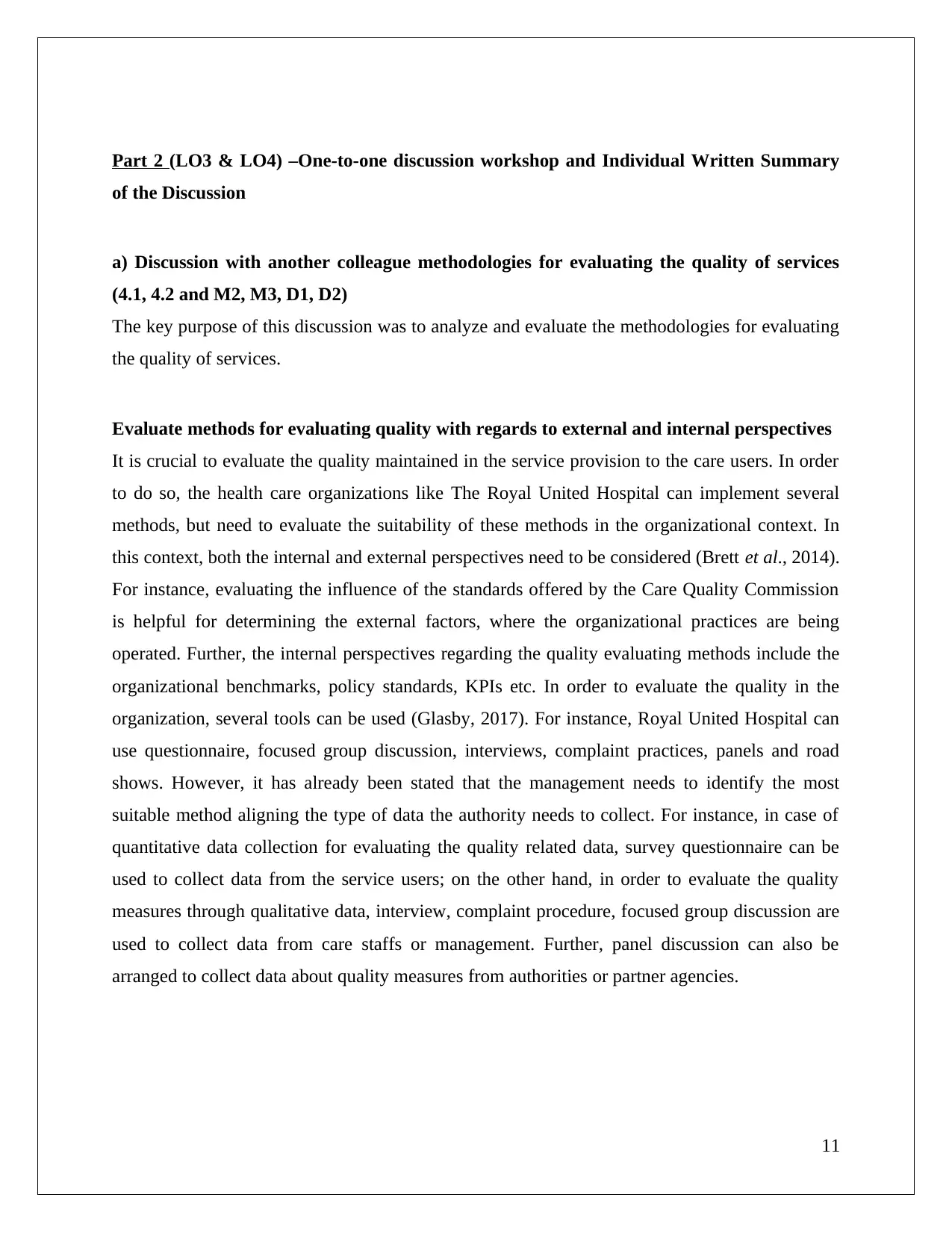
Part 2 (LO3 & LO4) –One-to-one discussion workshop and Individual Written Summary
of the Discussion
a) Discussion with another colleague methodologies for evaluating the quality of services
(4.1, 4.2 and M2, M3, D1, D2)
The key purpose of this discussion was to analyze and evaluate the methodologies for evaluating
the quality of services.
Evaluate methods for evaluating quality with regards to external and internal perspectives
It is crucial to evaluate the quality maintained in the service provision to the care users. In order
to do so, the health care organizations like The Royal United Hospital can implement several
methods, but need to evaluate the suitability of these methods in the organizational context. In
this context, both the internal and external perspectives need to be considered (Brett et al., 2014).
For instance, evaluating the influence of the standards offered by the Care Quality Commission
is helpful for determining the external factors, where the organizational practices are being
operated. Further, the internal perspectives regarding the quality evaluating methods include the
organizational benchmarks, policy standards, KPIs etc. In order to evaluate the quality in the
organization, several tools can be used (Glasby, 2017). For instance, Royal United Hospital can
use questionnaire, focused group discussion, interviews, complaint practices, panels and road
shows. However, it has already been stated that the management needs to identify the most
suitable method aligning the type of data the authority needs to collect. For instance, in case of
quantitative data collection for evaluating the quality related data, survey questionnaire can be
used to collect data from the service users; on the other hand, in order to evaluate the quality
measures through qualitative data, interview, complaint procedure, focused group discussion are
used to collect data from care staffs or management. Further, panel discussion can also be
arranged to collect data about quality measures from authorities or partner agencies.
11
of the Discussion
a) Discussion with another colleague methodologies for evaluating the quality of services
(4.1, 4.2 and M2, M3, D1, D2)
The key purpose of this discussion was to analyze and evaluate the methodologies for evaluating
the quality of services.
Evaluate methods for evaluating quality with regards to external and internal perspectives
It is crucial to evaluate the quality maintained in the service provision to the care users. In order
to do so, the health care organizations like The Royal United Hospital can implement several
methods, but need to evaluate the suitability of these methods in the organizational context. In
this context, both the internal and external perspectives need to be considered (Brett et al., 2014).
For instance, evaluating the influence of the standards offered by the Care Quality Commission
is helpful for determining the external factors, where the organizational practices are being
operated. Further, the internal perspectives regarding the quality evaluating methods include the
organizational benchmarks, policy standards, KPIs etc. In order to evaluate the quality in the
organization, several tools can be used (Glasby, 2017). For instance, Royal United Hospital can
use questionnaire, focused group discussion, interviews, complaint practices, panels and road
shows. However, it has already been stated that the management needs to identify the most
suitable method aligning the type of data the authority needs to collect. For instance, in case of
quantitative data collection for evaluating the quality related data, survey questionnaire can be
used to collect data from the service users; on the other hand, in order to evaluate the quality
measures through qualitative data, interview, complaint procedure, focused group discussion are
used to collect data from care staffs or management. Further, panel discussion can also be
arranged to collect data about quality measures from authorities or partner agencies.
11
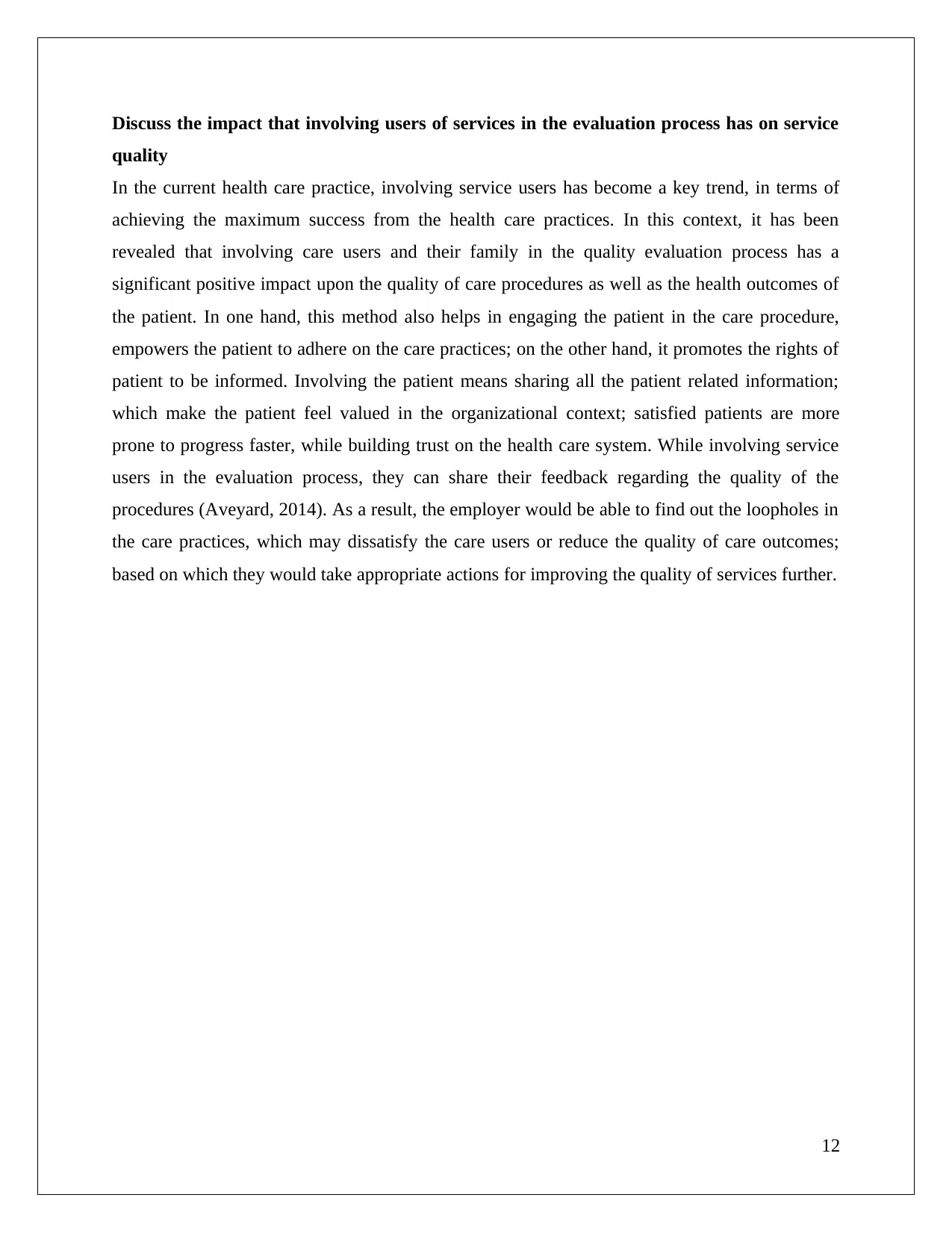
Discuss the impact that involving users of services in the evaluation process has on service
quality
In the current health care practice, involving service users has become a key trend, in terms of
achieving the maximum success from the health care practices. In this context, it has been
revealed that involving care users and their family in the quality evaluation process has a
significant positive impact upon the quality of care procedures as well as the health outcomes of
the patient. In one hand, this method also helps in engaging the patient in the care procedure,
empowers the patient to adhere on the care practices; on the other hand, it promotes the rights of
patient to be informed. Involving the patient means sharing all the patient related information;
which make the patient feel valued in the organizational context; satisfied patients are more
prone to progress faster, while building trust on the health care system. While involving service
users in the evaluation process, they can share their feedback regarding the quality of the
procedures (Aveyard, 2014). As a result, the employer would be able to find out the loopholes in
the care practices, which may dissatisfy the care users or reduce the quality of care outcomes;
based on which they would take appropriate actions for improving the quality of services further.
12
quality
In the current health care practice, involving service users has become a key trend, in terms of
achieving the maximum success from the health care practices. In this context, it has been
revealed that involving care users and their family in the quality evaluation process has a
significant positive impact upon the quality of care procedures as well as the health outcomes of
the patient. In one hand, this method also helps in engaging the patient in the care procedure,
empowers the patient to adhere on the care practices; on the other hand, it promotes the rights of
patient to be informed. Involving the patient means sharing all the patient related information;
which make the patient feel valued in the organizational context; satisfied patients are more
prone to progress faster, while building trust on the health care system. While involving service
users in the evaluation process, they can share their feedback regarding the quality of the
procedures (Aveyard, 2014). As a result, the employer would be able to find out the loopholes in
the care practices, which may dissatisfy the care users or reduce the quality of care outcomes;
based on which they would take appropriate actions for improving the quality of services further.
12
⊘ This is a preview!⊘
Do you want full access?
Subscribe today to unlock all pages.

Trusted by 1+ million students worldwide
1 out of 18
Related Documents
Your All-in-One AI-Powered Toolkit for Academic Success.
+13062052269
info@desklib.com
Available 24*7 on WhatsApp / Email
![[object Object]](/_next/static/media/star-bottom.7253800d.svg)
Unlock your academic potential
Copyright © 2020–2025 A2Z Services. All Rights Reserved. Developed and managed by ZUCOL.

